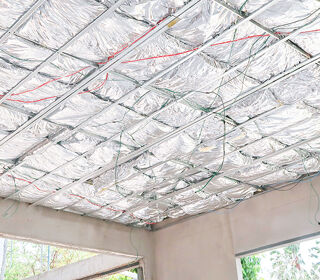
Blog Article

Poor indoor air quality and overheating can affect housing residents' health and comfort, yet a number of factors including building regulations contribute to the proliferation of these issues in new housing. This research aims to review current user experiences to propose cost effective scalable construction solutions to improve the indoor environmental quality (IEQ) of new houses.
Researchers
- Dr Monica Mateo-Garcia
- Prof David Boyd
- Visiting Prof Mike Leonard
PhD students
The project is supported by leading UK home builders, Barratt Developments Taylor Wimpey, Redrow; and Midland Heart Housing Association.
Research background
Thermal comfort, indoor air quality (IAQ), acoustics and lighting levels have proven to be important factors significantly affecting building users comfort, well-being and work performance. However, knowledge about the effects of the latest advances in low-carbon design and technologies have on users’ health and well-being is still limited. Also, new requirements for compliance with building standards can cause unintended consequences such as overheating, compromising the thermal comfort of occupants. There is therefore a need to better understand the factors that affect users comfort and well-being in indoor environments so residential dwellings can be improved not just in terms of energy savings but also in providing healthy and comfortable environments. This understanding is required in order to create interventions that are economic and effective against the variety of occupant behaviour and the environmental context, with solutions that are adaptive and easy to implement. The Government have recognised this issue and has included overheating as a key issue in the current review of Part L and Part F of the Building Regulations. Developers are concerned about reputation damage and an increasing threat of legal claims.
Research aims
The aim of the project is to propose cost effective scalable construction solutions and strategies that take account of human behaviours with the potential to improve the indoor environmental quality (IEQ) of new houses. The research will seek to analyse the factors that affect users comfort and well-being in indoor environments so residential dwellings can be improved not just in terms of energy savings but also in providing healthy environments.
Research methods
The research project includes: monitoring the indoor environment parameters in unoccupied and occupied dwellings across the UK, facilitated by project partners; gathering user’s feedback on thermal comfort and wellbeing and evaluating the data obtained to propose cost-effective solutions than can improve the air quality of indoor environments and thermal comfort in new developments.
Projected outcomes
This research will provide benefits to housing developers through avoiding complaints from overheating and poor indoor air quality, as well as promote healthy indoor environments as feature of their housing developments. This will be a unique selling point (USP) and provide positive publicity. Housing developers will increase their knowledge about overheating and indoor air quality, recognising at risk housing and addressing practical solutions for sustainability, and wellbeing. The practical knowledge and solutions will be used for the development of more operationally successful future housing designs. In addition to this, there will be benefits for the society translated into reduced costs to the health service associated with poor air quality such as asthma in children and premature deaths amongst the elderly due to overheating.